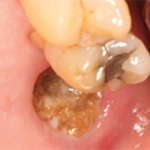NEW YORK (Reuters Health)—In postmenopausal women and men treated for at least two years with denosumab, a single infusion of zoledronate given after denosumab discontinuation does not completely prevent bone turnover and loss, researchers say.
Given the findings, “bone mineral density (BMD) should probably be higher than the current target for discontinuation of bisphosphonate treatment when considering discontinuation of denosumab,” Dr. Anne Sophie Soelling of Aarhus University Hospital, Denmark, tells Reuters Health by email.
Dr. Soelling and colleagues recruited 61 patients with osteopenia who were discontinuing denosumab after about six years. Patients were randomly assigned to receive zoledronate six or nine months after the last denosumab injection or when bone turnover had increased beyond a certain threshold—but no later than month 6.
Patients were monitored using DXA and bone turnover markers. The primary endpoints were change in lumbar spine BMD six months after zoledronate and the proportion of patients who failed to maintain BMD.
As reported in the Journal of Bone and Mineral Research, 59 postmenopausal patients (mean age: 68; 87% women) completed follow-up 12 months after the last zoledronate injection. The majority (70%) had been treated with alendronate before denosumab, reflecting the fact that in Denmark denosumab can be reimbursed only if a patient does not tolerate or has contraindications to alendronate.1
Six months after zoledronate, lumbar spine BMD had decreased significantly by a mean of 2.1%,4.3% and 3.0% in the six-month, nine-month and observational groups, respectively; 12 months after zoledronate, it had decreased by a mean of 4.8%, 4.1%, and 4.7% – i.e., no between-group differences.
BMD loss beyond the least significant change was seen in all groups; loss at the spine in 30% of the six-month group; 45% of the nine-month group; and 47% of the observational group. Additional loss at the total hip occurred in 5% of the six-month group; 25% of the nine-month group; and 11% of the observational group.
Further, in the six-month group, p-cross-linked C-terminal telopeptide (p-CTX; marker of bone turnover) decreased initially, but increased rapidly thereafter; six months after zoledronate, p-CTX was 0.60 g/L.
Similarly, p-CTX increased rapidly in the nine-month and observation groups, was suppressed by zoledronate, but increased again to 0.47 mcg/L and 0.47 mcg/L six months after zoledronate in both groups.
Further, incident vertebral fractures were seen in two women in the nine-month group.
Dr. Solling says, “Based on the rapid increase in p-CTX after the initial decrease in the six-month group, we speculate that some patients would benefit from a second treatment with zoledronate three to six months later. This needs to be investigated in a clinical trial.”
Deena Adimoolam, MD, associate fellowship program director in the Division of Endocrinology, Diabetes, and Bone Disease at Icahn School of Medicine, Mount Sinai, New York, comments in an email to Reuters Health, “This study has a few limitations, one being that the sample size is very small to make significant conclusions.”
“Patients were studied over a 12-month time frame, which may not have been long enough to evaluate for a clinically significant change in BMD by DXA scan,” she says.
“The main downside to setting a higher BMD target,” she said, “is that majority of patients taking denosumab will have stable BMD—most do not demonstrate an increase in BMD. So if higher BMD is used as a target before discontinuation of denosumab, it might not actually be attainable by many patients.”
“Also, the longer one stays on denosumab, the higher the risk for side effects,” she adds.
Reference
- Solling AS, Harslof T, Langdahl B. Treatment with zoledronate subsequent to denosumab in osteoporosis: A randomized trial. J Bone Miner Res. 2020 May 27. Online ahead of print.

